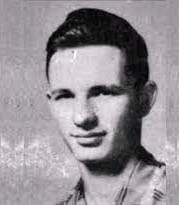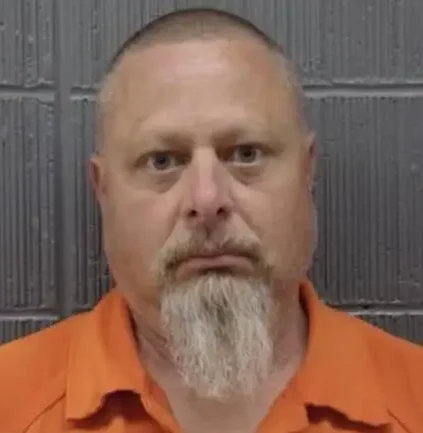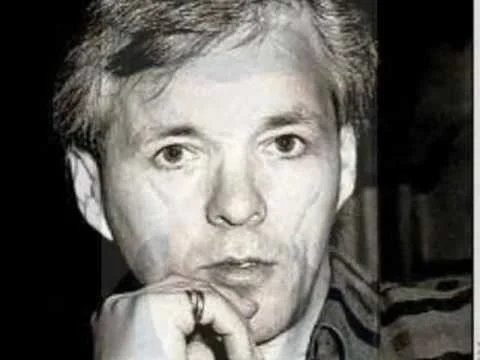
In May 1998 convicted killer was released from a prison in Austria, having only served 15 years and four months behind bars, his name – Jack Unterweger. Unterweger was living the double life, of a celebrated writer and that of a serial killer. Once released from prison he went on to kill nine women and was suspected of a further two in just over a year. His victims all died in the same way, each strangled using the same knot. In public he was the poster boy of prison reform in Austria who transformed from murderer to model citizen.
In June 1976, 25 year-old Jack Unterweger was found guilty by a court in Salzburg Austria of the brutal murder of a young German woman. Unterweger confessed. He was sentenced to life. However, Unterweger served just over 15 years. He was released in May 1990 and only a few months later prostitutes started to disappear. Unteweger was suspected of murdering 11 women, but was convicted of just nine. Dr. Elizabeth Yardley, criminologist: ‘’I’m absolutely astounded at the fact that Unterweger was released from prison many, many years before he should have been. People like Unterweger can change. They can change in prison, if they acknowledge that what they’ve done is wrong and, if they undertake work to address those traits and those behaviors that lead them to the decision to harm others, but he didn’t go through that process at all.’’ Geoffrey Wansell, author and journalist: ‘’He was without question perverted, depraved killing machine and I can think of very few, probably less than 20, who would deserve comparison with him. It’s an extraordinary story and one which sends a shiver down my spine every time I tell it.’’
Johan Jack Unterweger was born on the 16th of August, 1950 in Judenburg, Styria, Southern Austria. He was the illegitimate son of a waitress and an American soldier, who left before Jack was born. His mother didn’t take care of him. Actually, she spent short spells in jail. Dr. Reinhard Haller, court psychiatrist: ‘’Jack Unterweger clearly had issues. He grew up without a father. His mother over the years developed a serious alcohol problem. Due to this, little Jack grew up in a Hut in Corinthia with his grandfather. He was exposed to many things a child should not see.’’ Dr. Elizabeth Yardley, criminologist: ‘’He was also learning things about women from his grandfather, who was a notorious philanderer. He’s learning that women are there to be used and abused and discarded, so that’s something that’s ingrained in him from quite an early age.’’ Dr. Reinhard Haller, court psychiatrist: ‘’He also saw his grandfather bringing his lovers or rather prostitutes to this Hut again and again. At the four-year-old boy witnessed their sexual activities and much more and so there was this negative impact on his early years.’’ In 1958 Unterweger stayed with his relatives, but then he was placed in the foster care system. Dr. Elizabeth Yardley, criminologist: ‘’He didn’t form those attachments with his caregivers. Those consistent attachments that provide that secure environment in which children can grow up and feel safe and develop. A child in this kind of situation… They become very, very focused on their own survival.’’ Dr. Reinhard Haller, court psychiatrist: ‘’He almost inevitably fell into this criminal role and showed this type of behavior from a very early age. He failed in his compulsory education and he displayed delinquent behavior in his youth.’’ According to some sources he was a pimp.
In December 1974, aged 24, Unterweger’s was traveling with his girlfriend through Germany when they drove past a friend of hers, 18 year – old, Margaret Sheffer. They stopped and robbed her, driving to her parents house to rob them too. Unterweger then took the 18 year – old girl to a nearby wood and ordered her to undress. He tied her up, beat her with a steel rod and then strangled her with her own bra. In 1975 during the trial of his first murder Unterweger was assessed by a psychiatrist. He was diagnosed as an extremely dangerous unpredictable and incurable individual. The report stated he demonstrated egocentricity, aggressiveness and sexual perversion with a sadistic component. Dr. Elizabeth Yardley, criminologist: ‘’Psychopaths are people who feel and behave and relate to others in ways that are different from the rest of us. The way that I often describe psychopathy is: it’s a form of emotional emptiness, so there aren’t that complex range of emotions that the rest of us have, like love and guilt and regret. It is quite black and white for psychopaths: I want this particular thing and I’m going to not stop, until I’ve got it.’’ Dr Reinhard Haller: ‘’This was a highly sadistic murder in which he abducted this girl who was walking home on an extremely cold winter’s night. He drove her naked through the forest with a steel rod in his hand, taking great delight in her impending death from exposure. But, ultimately strangled her with her bra. It was an incredibly vicious and incredibly sadistic moment.’’ Dr. Elizabeth Yardley, criminologist: ‘’So he sees an opportunity here. He sees this woman walking, who his girlfriend knows, there’s an opportunity there for him to have control over somebody to manipulate them and to do what he wants with them.’’ The police questioned Unterweger’s girlfriend and she confessed that he had killed her friend. Once in police custody, Unterweger also confessed to the killing, claiming he had a fit of rage.
On the 1st of June, 1976, before his 26th birthday, Unterweger began a life sentence for the murder. He cried during sentencing. Geoffrey Wansell, author and journalist: ‘’From being, what could only be described as a low-life, uneducated brute, capable of killing an 18 year – old, he suddenly becomes a changed man. he teaches himself to read and write properly, and he begins at very adventurous career as a writer. In fact, writes, not one, but two bestsellers. He is very much the model prisoner.’’
Dr. Reinhard Haller, court psychiatrist: ‘’One day in the library he came across a book by an author completely unknown to him and he says to himself, quite narcissistically, what he can do I can do too. And then he began to write stories and, paradoxically, he wrote, among other things, these episodes for a radio program, which was very popular among children and families back then. It was called the ‘’Bedtime program for little ones – The little sandman is coming. This was such a very idyllic, lovely, comforting, soporific program, which I also listen to as a child.” Unterweger became famous as the man who wrote children’s stories, poetry and prose about life in prison. His autobiography ‘’Fegefeuer’’ meaning ‘’Purgatory’’ became a bestseller and was made into a film. The Austrian literati were amazed by his transformation and at the time Austria was in the midst of reforming its prison services. Jack Unterweger’s was just what the reformers needed to prove the new system could be successful. Dr. Paul Yvon, journalist: ‘’Suddenly attracted the attention of the media, People showed support for his release. These were people, some of whom were very well known, like journalists and artists, who showed their support for good reasons. Let’s say they had good intention.” Dr. Reinhard Haller, court psychiatrist: ‘’The intellectuals said ‘wonderful, finally we have a criminal who reformed himself, who as it were confessed to his actions through his writing, and processed them therapeutically, such a person can only be a good person’ and they fell for him, they really fell for him.’’ Intellectuals, artists, writers, journalists and even politicians campaigned for Unterweger to be free.
Dr. Reinhard Haller, court psychiatrist: ‘’Now there was unbelievable pressure for his release at all costs, and that’s what finally happened. However, there were voices who warned that hiding behind this charming and manipulative man is a very dangerous, malicious narcissist.’’
On the 23rd of May, 1990, 39 year – old Jack Unterweger was released from Stein prison in Austria. Dr. Reinhard Haller, court psychiatrist: ‘’He was actually released without any safeguards. That means he did not to go to see his probation officer or to a psychiatrist. He would have been treated further. He was completely free.’’
Geoffrey Wansell, author and journalist: ‘’A brutal killer who is now going to embark on what, I think, is one of the most horrifying killing sprees in modern European history.’’
Unterweger moved to Vienna where he mingled with the rich and famous. ’’ Dr. Elizabeth Yardley, criminologist: ‘’So he was the success story of the criminal justice system and, I think, we got to carried away with that, and lost sight of the fact that this was an individual who had harmed someone else, who had taken someone else’s life, and that wasn’t something that had been addressed. So, of course, he was going to do it again.’’ Dr. Reinhard Haller, court psychiatrist: ‘’He was very charming, quite intelligent, but also a highly manipulative person who was not mentally ill, but had an abnormal personality.’’ Geoffrey Wansell, author and journalist: ‘’He moves to Vienna, becomes the darling of Cafe Society, buys a white Ford Mustang. This is a man with some considerable vanity and turns himself into a famous guest, part-time journalist, writer, television studios, radio talks, reads his poetry to adoring crowds, many of them women, and generally struts his stuff.’’ In 1990, he joined a panel with journalist Paul Yvonne, to discuss prison reform. Dr. Paul Yvonne: ‘’He was invited as basically an expert, to report on his experiences in the penitentiary. He happened to sit next to me in this club. He appeared in a white suit, as far as I could remember he had a bright red carnation, I think, in the buttonhole. The normal reaction of a journalist is curiosity and interest – what kind of guy, what kind of person is he is.’’
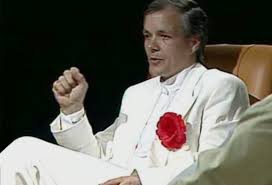
Dr. Elizabeth Yardley, criminologist: ‘It’s very easy for Unterweger to lead a double life because he can very effectively compartmentalize parts of his life and his existence. He’s a very accomplished actor at this point. He’s playing this role of the reformed criminal, of the man who’s changed and he’s absolutely loving the spotlight that comes along with it, so he wants that. That narcissistic element of him wants that continued attention and this adoration.’’

Dr. Paul Yvonne: ‘’He also showed up in various bars where he always picked up women. What’s really impressive is the incredible number of women he had made contact with. I believe he did not spend one night alone and very few nights with the same woman.’’ Dr. Reinhard Haller, court psychiatrist: ‘’He possessed what one calls the charm of a psychopath.’’ Women adored him because he represented ”bad boy” image – tattooed body on shirtless pictures in magazines and, on the other hand a writer, gentleman who discussed prison reform on television.
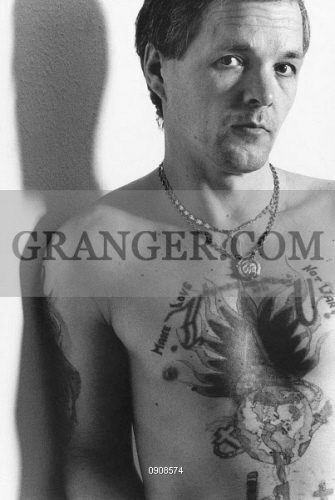
Chris Carter, author: ’’A lot of people will come out of prison, they don’t even have a job and they’ll have to struggle probably for the rest of their lives, but he came out and he had money, he had a job, he already had a career pretty much set up, so he had all the opportunity. But the problem with killers is that they can’t curb the urge.’’ Geoffrey Wansell, author and journalist: ‘’He is a man who’s positively bursting with self-importance and vanity, but he is also the same man who was cruel, manipulative and violent towards women from the age of 16 onwards. Nothing has changed. Only this time he chooses his targets carefully.’’

In September 1990, just four months after his release from prison, Unterweger killed again and this time to the country formerly known as Czechoslovakia. She was the 29 year – old shop assistant in Prague, Blanka Bochkova. Her body was found on the banks of the Vltava river, lying on her back with her legs wide open and covered with twigs and leaves. She’d been strangled with a pair of stockings. The last time she was seen alive was at a bar talking to a well-dressed man, around 40 years old. Geoffrey Wansell, author and journalist: ‘’I can only imagine, that it must have emboldened him incredibly. I mean, he must have felt literally godlike ‘I can do whatever I want, I can dress them and undress them’. This is a man who has contempt for women. That’s the only possible word for it. Utter contempt. And what’s more, he intends to indulge himself as long as he can get away with it. And my goodness, does he get away with it.’’
A month after the murder in Prague, in October, 1990 Unterweger murdered three women. The body of Brunhilda Masser was found naked in a forest, near Gratz in Austria, nearly three months after she disappeared. In December, 1990 Heidi Hammerer was killed in a forest, near Lustenau now, close to the German border. Both women had been beaten and strangled with their tights. March, 1991, Elfriede Schrempf disappeared near Gratz. Her body was only found seven months later. Dr. Stuart Hamilton, forensic pathologist: ‘’We’re looking at somebody who strangled his victims, but then disposed of the bodies in the open air in forests and it was often a long time, weeks or months before they were discovered. Obviously the decomposition process, the fact that animals have access to those bodies, will damage them. It will limit what the pathologist can say, but quite often the body is much better preserved than necessarily you would think at first glance, and quite often at least some information can be gleaned. If there was say, bruising in the tissues of the neck from a strangulation, it would still be relatively identifiable. In some cases we could never say what happened, in others the evidence can still remain quite strong for prolonged periods.’’
Dr. Elizabeth Yardley, criminologist: ‘’When we look at the murders he commits after he left prison, they are much more meticulously planned. The first murder was very much an opportunity which he took advantage of and that the circumstances around that, left an awful lot of evidence behind. there was a witness… So, of course, he was going to be convicted for that. So when he comes out, he’s sure, he’s not going to make those same mistakes again. And he’s very careful, he plans. He’s incredibly organized.’’
Little is known about where exactly the victims died and what happened to them before they died. Unterweger picked them up in his car and presumably drove them to an isolated area in a forest. Dr. Reinhard Haller, court psychiatrist: ‘’We do know a few things, because one of his victims survived and from this evidence it is quite clear that sexual acts were involved too, but, in my opinion, these were not a prime importance, of prime importance was the sadism – that he wanted to torture the women, that he wanted to exercise power and all circumstances.’’
Dr. Elizabeth Yardley, criminologist: ‘’If you look at the method that he used for killing his victims, he strangled them and that is the ultimate control method, in terms of a way of killing somebody. You are face to face with them, you are seeing the life drain out of them. You can choose to stop, you can choose to carry on.’’
Unterweger’s victims were found naked or half-naked, lying face down with their legs spread apart and partly covered with twigs and leaves. This was his MO.
Dr. Reinhard Haller, court psychiatrist: ‘’We always see this practice with serial killers. They perform almost ritualized killings and at the end, they also have a funeral. In his case, it consisted of covering half of the corpse, as was discovered with some of the skeletons.’’
Dr. Elizabeth Yardley, criminologist: ‘’He’s learned that women are there to be used, abused and discarded. That’s something that he’s learned from an early age. He knows that that’s wrong, but he chooses to do it anyway, because he enjoys doing it. He likes to dominate others. He likes to have that feeling of power over other people and, because he has no compassion, he has no empathy for the suffering of others, he’s an incredibly dangerous man.’’
March, 1991, Unterweger was a charming, wealthy and influential poet. living the high life in Vienna’s Coffee Culture Society, while murdering women. Since leaving prison, he had killed at least four women. But then he murdered three prostitutes in Vienna.
Geoffrey Wansell, author and journalist: ‘’It’s an act of the most incredible arrogance. Add vanity to arrogance and you have a vision of Unterweger’s view of himself. And we are talking about man now who is on a spree, full out spree. He chooses wisely, he’s clearly trawling red light districts. It’s hard to miss Unterweger, because he’s driving a white Ford Mustang. But no one puts two and two together. Dr. Elizabeth Yardley, criminologist: ‘’He’s always had a sense of entitlement, he’s always felt like he deserves better than other people. But at the same time, he’s also got those lessons that he’s learned from his early years, that women are there to be used and abused and discarded, so women are the vehicle through which he achieves the the control that he craves.’’
A reporter, claiming to be working for the Austrian public broadcaster ORF, was investigating the strange disappearance of sex workers in Vienna for a radio program. His name – Jack Unterweger.
Dr. Reinhard Haller, court psychiatrist: ‘’In Austria there are 0.5 to 0.7 killings of prostitutes per year, and now, suddenly, there were seven or eight cases within a year. This was conspicuous. And then the top crime detective got a visit from a reporter named Jack Unterweger, who was equipped with a microphone, and asked him ‘there are so many prostitutes being killed in Austria, the population is worried. That’s a scandal! Why have the police not been more successful?’ and during one of these live interviews this official told him ‘yes, we’re checking up on all sexual murderers, including you’.’’
Dr. Elizabeth Yardley, criminologist: ‘’And he’s loving every minute of this, because he knows that he’s the one behind the murders that he’s talking about. And psychopaths enjoy playing with people, they enjoy kind of pressing their buttons and having a bit of fun, and knowing that they’re the ones who’ve got this knowledge that other people don’t. So, he’s essentially, he’s having a good time, this is amusing for him he’s getting a lot of gratification out of it.’’ Unterweger’s radio program was reporting on crimes, so he had a reason to visit the red light district, explaining why his white Ford Mustang, with the registration W Jack One, one was spotted and why he was seen talking to prostitutes. Geoffrey Wansell, author and journalist: ‘’It is the state of the most extraordinary vanity and arrogance, rolled into one. Not only am I killing the prostitutes, now I’m reporting on the fact that I’ve terrified the prostitutes in Vienna. It is, I mean, it is truly astonishing, absolutely and, I use the word, rarely that is astonishing.’’ Chris Carter, author: ‘’He might have done it just to tease the police. Some serial killers, they do. The longer you go without having people after you, people, knocking on your door, the more cocky you get. Dr. Elizabeth Yardley, criminologist: ‘’He’s presenting himself as the champion of these women’s rights, as their defender, as somebody who really does genuinely care about them. So, this is really, really chilling stuff.’’
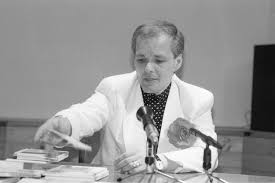
Police in Vienna did have Unterweger on their list of possible suspects, but they had no hard evidence. Unterweger often had an alibi for the days on which the crimes happened: he’d either been to a reading, given a radio interview, or being with a girlfriend. Geoffrey Wansell, author and journalist: ‘’Now, not everyone is completely convinced by Unterweger. Certainly one police officer is beginning to see similarities with the crime that he was, eventually, convicted for, a killing of the 18 year – old with a steel rod. In fact, that police officer also suspected he may have killed once before, but those odd suspicions do not affect his celebrity in Vienna. Indeed, he’s so celebrated and so brazen, gets commissioned to go to Los Angeles to write peace about prostitution.’’
In June, 1991, Unterweger traveled to the U.S. He stayed in the former Cecil Hotel in Downtown L.A.. It had a reputation for violence and suicide at the time. Unterweger was not the first serial killer to have stayed there. It was already famous as the hangout of the Night Stalker ‘’Richard Ramirez’’ Within a few weeks of landing, he had killed three women in Los Angeles, all of them prostitutes. Dr. Elizabeth Yardley, criminologist: ‘’And, I think, there was that sense in which he was getting a bit bored. And often you see this with psychopaths. They have that proneness to boredom and that need for stimulation. So they will often start to vary their offending behavior, to mix things up a bit, and to keep it interesting. So, I think, potentially that was what lay behind the decision to continue killing people outside of that country.’’ All three murders were meticulously planned in advance. Unterweger’s first L.A. victim was Shannon Exley, a prostitute, allegedly, popular with truckers. Nine days later he killed again, Irene Rodriguez, originally from Texas and five days after that he killed Sherry who was later found in the hills of Malibu. All three women were strangled with a bra, using the same very distinct knot, a signature. Chris Carter, author: ‘’Some people use a certain method, for example, with strangulation that would be the MO (modus operandi), but if they use this strangulation with a cord then the cord will be the signature. In his case I don’t think he used the bra off the girls a lot of the time, but he did a specific knot I don’t think he did a knot, because Unterweger wanted people to know it was him, he did a knot because he knew that worked. And it’s the same thing that happens with so many serial killers. They use the method or signature because they know it works.’’
Unterweger left LA and returned home to Vienna before detectives could link him to the murders. But while he was away, the police in Vienna were now working closely with their counterparts in Grunts, the site of the murders after he was released from prison. They realized the murders were, in fact, linked. A pattern started emerging, with Unterweger being in the same area of Austria, that the murders were committed. The police realized they were now dealing with a serial killer.
On the 13th of February, 1992, one year and nine months after he was released from prison, an arrest warrant was issued by the Gratz judiciary. Unterweger had fled with his girlfriend, this time to Miami but his escape didn’t last long. Geoffrey Wansell, author and journalist: ‘’He’s finally tracked down to Florida in the United States, because the authorities have begun to put various parts of the puzzle together and he’s arrested and extradited in May, 1992, to stand trial in Austria. Later his then girlfriend with whom he had fled said that he demanded from her to work for him in strip bars, actually that he was exploiting her.
He gave interviews about his innocence and that he couldn’t stand to be in prison psychologically. Dr. Elizabeth Yardley, criminologist: ‘’When he talks to the television camera, he says ’I’ve only had two years of freedom’ and he appears to be quite upset. We shouldn’t be fooled by that. The only person that he feels sorry for is himself, and this is a skilled manipulator. This is somebody who’s learned by observing the behavior of other people what kind of emotions he can display that will elicit some kind of sympathy.’’
During the extradition process detective and Geiger from the Vienna Police Department discovered further links to prove Unterweger’s guilt. He’d searched Unterweger’s home and found evidence of his visit to L.A., so he contacted the LA Police Department and discovered the three similar murders in their district. The evidence founded in Unterweger’s home placed him in the areas of each crime scene. The detective expanded his search across Europe, asking if there were any other unresolved murders with the same MO. Prague police replied with the case of Bochkova. She was the first woman Unterweger killed after his release from jail. The case was building and Unterweger was charged with the murders of 11 women.

The minor celebrity and poster boy of prison reform was again in police custody.
Chris Carter, author: ‘’It’s not often they get a killer who was that well known to a society and, in his case, it’s very interesting to me that he killed then he went to prison, then he came out early with a brand new profession and with an amazing chance of just carrying on with a brand new life, 10 times better than the life he had before, it just goes to show that the hate he had inside him towards women was so intense that nothing would stop him.

at the courthouse in Gratz.
Many of his friends from Vienna still believed in Unterweger’s innocence. But the prosecution had gathered strong evidence against him, including, for the first time in an Austrian murder case, DNA. The events attracted an enormous amount of media attention Dr. Paul Yvon, journalist: ‘’You had to register, which was something completely new back then. Having to register as a journalist in a public proceeding. This big group of his supporters, his fans, even the female ones, they were already nowhere to be seen or heard, because during the long pre-trial process many details had come to light which made it so clear. He was as guilty as sin.’’
Unterweger was defended by two lawyers during what was a complicated and lengthy trial. One of them was Dr. Hans-Jurgen Lehofer: ‘’Every single victim, every single murder had been examined. The whole thing took three months. With many of the victims it was no longer possible to establish how the women died, how they were murdered, because sometimes only the skeleton was left as the bodies had been in the forests.’’
The court was shown photographs of the first woman he killed after his release, Blanka Bochkova. She was murdered in September, 1990, in Prague. The shocking images left a deep impression on everyone in the courtroom, but not on Unterweger. Dr. Hans-Jurgen Lehofer, Unterweger’s lawyer: ‘’The judge then asked ‘are there any questions?’ and Unterweger then tells me quite excitedly ‘go on, ask him something, ask already’ obviously he was not affected by the image of this naked girl, the corpse and this person who was strangled, whose facial expressions are not pretty. He kept telling me to ask ‘ask, ask’. I didn’t know what to ask. I wasn’t able to ask, but he didn’t care ‘go on, ask, ask, ask’.’’
For two of the murders the prosecution presented DNA evidence. A hair belonging to victim Blanka Bochkova had been found in Unterweger’s car and red fibers found on another victim’s body corresponded to a red scarf found in Unterweger’s home.
When Unterweger was first asked by police about his whereabouts in Prague, unaware of possible DNA evidence, he answered that he had been to the city but that he hadn’t picked up anyone. Dr. Hans-Jurgen Lehofer, Unterweger’s lawyer: ‘’If he had said I met a girl there, took her to my car and we did things together, going for a ride, drinking a beer or something, then it would have been possible to explain why a girl’s hair was in his car. But because he said I never took a girl in my car in Prague, now the question was how did Bochkova’s hair get into the car of Jack Unterweger. This practically sealed the chain of evidence.’’
Another key piece of evidence was Unterweger’s modus operandi – he strangled his victims, always using the same kind of knot. Austrian police got in touch with the FBI in the U.S and asked if there was a way to analyze this specific knot. An American specialist had the answers they needed. Dr. Paul Yvon, journalist: ‘’She was asked for her opinion on the knots, she said ‘I tell you the same thing I told the Austrian investigators at the time: if you find the person who tied one of these knots, then you’ve undoubtedly found the one who tied all these knots, this is a very special knot’
Dr. Hans-Jurgen Lehofer, Unterweger’s lawyer: ‘’I can remember how this American woman had the original bra in her hand and showed it to the jury. You could see how tightly the neck was constricted by the knot and I think that was the turning point in the process. That’s when I could really notice it – one had to imagine that the victim’s neck was compressed to this diameter. Dr. Paul Yvon, journalist: ‘’That was a moment when it was dead quiet in the overcrowded courtroom, even though there were hundreds of people in there and Jack Unterweger who has always had such a particularly straight, present, slightly dominant posture and it always looked with a certain, I would say, impudence, as if to say ‘look I have nothing to hide’.’’ Dr. Hans-Jurgen Lehofer, Unterweger’s lawyer: ‘’The horror of the jury when they saw this bra could really be felt physically, and that was also the turning point, when the mood turned against Unterweger.
Dr. Paul Yvon, journalist: ‘’That was the moment when you could see it in his body language He slipped back into his seat and grew smaller and smaller; his color drained and then he just sat there, I was thinking, now that was the moment – this is it, the hunt is over.
But Unterweger stood by his innocence to the very end. The Austrian jury consisted of eight members. if the verdict is at least four against four, the accused goes free. Throughout the trial Unterweger regularly talked to Dr Haller in his prison cell. He would discuss how he thought the jury was reacting on each day. Dr. Reinhard Haller: ‘’He closely monitored the eight jurors during the trial. He always knew who were skeptical, who were against, him who were for him and he told me every day after the trial ‘today four were for me and four against me; today three were skeptical’ and so on.’’
Dr. Elizabeth Yardley, criminologist: ‘’People like Unterweger are incredibly intelligent and they will pick up on other people’s emotions, other people’s feelings, even though they don’t have that complexity of emotion themselves. They learn through observing other people – the kind of behaviors that they need to display, the sorts of things that they need to say to get what they want.’’
Geoffrey Wansell, author and journalist: ‘’Absolutely certain, he was confident in his own mind that he could convince at least four of them that he was innocent. Unterweger is so confident that he decides that he will give the final speech in his defense. Dr. Hans-Jurgen Lehofer, Unterweger’s lawyer: ‘’Unterweger then delivered, in my opinion, a brilliant concluding speech in his defense, but the jury vote was never eight to zero for guilty, rather it was always only five to three or six to two so they were always a few jurors who were still convinced of Unterweger’s innocence.’’
But Unterweger’s impassioned speech did not sway the jury on all charges.
On the 28th of June, 1994, at approximately 9 pm, the verdict was read out. He was found guilty of nine of the 11 murder charges against him and sentenced to life in prison. He placed an appeal against the verdict.
Unterweger then returned to his cell where six hours later he hanged himself with a string from his jogging bottoms and his shoelaces.
It was confirmed that the knot he used to tie the noose was the same he’d used to strangle his victims.
Jack Unterweger exhibited all the traits of psychopathy and he had a paraphilic disorder – sexual sadism. Dr. Reinhard Haller also diagnosed him with Narcissistic personality disorder, allegedly, but psychopathy has a symptom of grandiose sense of self. On the television show when he spoke about prison reform I noticed one of the traits Robert D. Hare, PhD selected as key symptoms of psychopathy: glib and superficial. In his American counterpart, Ted Bundy, I can not see it even if I watch million times. Robert D. Hare, PhD explained that symptom: ‘’Psychopaths are often witty and articulate. They can be amusing and entertaining conversationalists, ready with a quick and clever comeback, and can tell unlikely but convincing stories that cast themselves in a good light. They can be very effective in presenting themselves well and are often very likable and charming. To some people, however, they seem too slick and smooth, too obviously insincere and superficial. Astute observers often get the impression that psychopaths are play-acting, mechanically ‘reading their lines’.’’ I noticed the last part of explanation: ‘’mechanically ‘reading their lines’.’’
Austria did not give up on prison reform together with many other countries in Europe which made them more civilized than the rest of the world.
Apr 20, 2023 #CrimeDocumentaries#Documentaries#TrueCrime https://tinyurl.com/AbsoluteCrime#TrueCrime#Documentaries#CrimeDocumentaries
